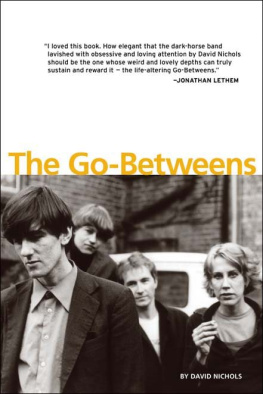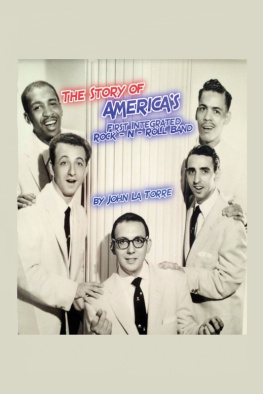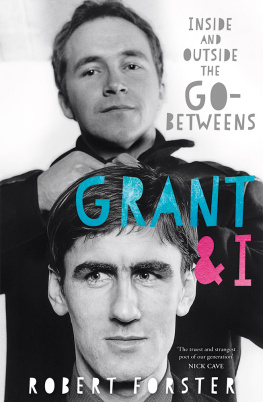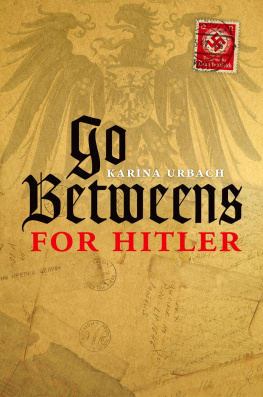THE GO-BETWEENS

The Go-Betweens
by David Nichols
Verse Chorus Press
1997, 2003, 2011 by David Nichols
All rights reserved. No part of this book may be reproduced, stored in or introduced into a retrieval system, or transmitted in any form or by any means (digital, electronic, mechanical, photocopying, recording, or otherwise) without the prior written permission of the publisher, except by a reviewer, who may quote brief passages in a review.
The original edition of this book was published in 1997 by Allen & Unwin (Australia). This expanded and completely revised edition was first published in 2003 by Verse Chorus Press.
Front cover photograph by Bleddyn Butcher
Back cover photograph by Peter Anderson
Design and layout by Steve Connell/Transgraphic services
The author and the publishers wish to thank all those who supplied photographs and gave permission to reproduce copyright material in this book. Every effort has been made to contact all copyright holders, and the publishers welcome communication from any copyright owners from whom permission was inadvertently not obtained. In such cases, we will be pleased to obtain appropriate permission and provide suitable acknowledgment in future editions.
Country of manufacture as stated on the last page of this book
ISBN 978-1-891241-90-1 (e-book)
Library of Congress Control Number: 2003109772
Verse Chorus Press
PO Box 14806, Portland OR 97293
For Stephen and for Mia
Contents
In 2001, I was interviewed by Fiona Dempster for her documentary on the Go-Betweens. Towards the end of the interview I found myselfweary, talked-out, a bit excited by my own unwarranted role in this whole epic adventurelambasting Robert Forster and Grant McLennan for reuniting under the Go-Betweens banner to record a new album, The Friends of Rachel Worth, eleven years after they originally broke up the band. I said it was a callous financial decision, and claimed that a reunited Go-Betweens would inevitably let down the people who would go to their shows, buy the records, and participate in the process. I hope this outburst doesnt get used in the film, but Ill wear it if it does. After all, I participated in the process, too.
The Go-Betweens was first published in Australia in 1997 by Allen & Unwin; it was reasonably well-received and sold reasonably well. Revisiting it in the course of preparing this new version, I am appalled by its messiness. That said, when the original tome came out, even the subjects of the book were positive about it, though McLennan claims (and I believe him) never to have read it, and Forster, who fact-checked the final draft, felt that the endingwhich, rather than eulogizing, discussed the importance of a brand name like the Go-Betweens to Forster and McLennanwas cold.
Hes right, it was coldbut it was appropriate at the time. In 1996, Forster and McLennan, still more famous and popular for their work in the Go-Betweens than for anything theyd subsequently done as individuals, were showing every sign of returning to the old umbrella. Their manager was keen for them to do anything under the Go-Betweens name. Their record company in England, Beggars Banquet, had effectively dumped them as solo artists, while reissuing the Go-Betweens albums in a uniform CD edition. And the willingness of Forster and McLennan to play shows togetherand to work together on other projectswhile refusing to make new Go-Betweens records was looking worse than perverse.
I wrote the original book because I wanted to write a book about an Australian rock scene, preferably one on the periphery, and preferably one with brilliant, funny, engaging characters. And of course I had always loved the Go-Betweens. Completely by accident, I picked the perfect timetwo or three years after the breakup of the original bandto conduct my interviews: the ex-members were still fuming at each other, and their friends were still divided into camps, but there had been enough time for people to begin to augment their anger or distress with theories, ideas, and explanations. From a historians point of view, it was a beautiful moment.
What you now hold is a rewritten (and even, due to the vagaries of computers, retyped) version of the 1997 book. Since Forster and McLennan have indeed recorded again together as the Go-Betweensnot once, but twiceand toured extensively, I have been able to pick up the Go-Betweens story and bring it into the present. The book still does not trace the solo yearsthe 1990sin ardent detail, though, any more than it traces the early lives of the participants. It is a book about a band. And the band, as you will see, is greater than the sum of its parts.
Between the original book and this one I mapped out two other rock books which would cover the 1960s and 1970s in Australia the way this one covers the late 1970s and 1980s. One is about Sydney pop primitive Pip Proud, the other about New Zealand/Australian group Dragon. I havent written them yet, but in the meantime I welcome the chance to return to my first book and improve it, or at least to replace the old typos with some new ones. This book was rewritten in an environment of domestic harmony, a Melbourne summer in West Brunswick, with a really good gelato shop up the road and a new Go-Betweens albumthis time, a great onespinning on the CD player. I hope the enthusiasm and the affection I have for this remarkable group shows through.
DAVID NICHOLS
Melbourne, 2003
I want to thank all the people who agreed to talk to me for this book. Not everyone listed here has been quoted directly in the final text, but their recollections, opinions, and ideas were invaluable. They are, alphabetically: Eric Auerbach, Colin Bloxsom, Leigh Bradshaw, Amanda Brown, Carrie Brownstein, Mark Callaghan, Wayne Connolly, Larry Crane, Robert Forster, Keith Glass, Robin Gold, Dave Graney, Roger Grierson, Phil Grizzly, Erhard Grundl, Mick Harvey, Alan Horne, Rowland Howard, Ed Kuepper, Peter Loveday, Irena Luckus, David McClymont, Clare McKenna, Grant McLennan, Ashleigh Merritt, Clive Miller, Steve Miller, Clare Moore, Lindy Morrison, Temucin Mustafa, Michael OConnell, Alec Palao, Adele Pickvance, Matthias Strzoda, Peter Sutcliffe, Deborah Thomas, Glenn Thompson, Geoffrey Titley, Dave Tyrer, Victor Van Vugt, Robert Vickers, Clinton Walker, Dan Wallace-Crabbe, Peter Walsh, David Westlake, John Willsteed, and Andrew Wilson.
I was also aided enormously by: my mother, Jane Miller; Karin Bumler, who gave me some invaluable advice; Mark Louttit, who was in on the GoBs early days and gave me a copy of the early ZZZ tape which first inspired the wish to write this book; Bleddyn Butcher; Tony Moore; Karin Sprey; Michelle Cannane; Sophie Cunningham; Barry Divola; Wayne Davidson; Ian McFarlane; Graham Nichols; Bruce Milne; Gary Warner; Michael Conarty, who filled me in on the GPS business; Kristin Wallace-Crabbe; Bill Meyer; Fiona Graham and Bronwyn King, who read an early draft and asked sensible questions about who the fuck all the people were; Jen Matson, who gave me some interview tapes and was generally friendly; Ben Clancy; Dan Cross; Robert Hope; Jerry and Charlotte; Brigitte Salden; Mary Mihelakos; Shane Moritz; Richard Kingsmill; the staff of Fisher Library, University of Sydney; and the state libraries of New South Wales, Queensland, and Victoria, all of whom will no doubt be very excited to see themselves mentioned here (though frankly I cant remember why I thanked them in the original bookbut I did, and Im doing so again).
Ian Wadley was very helpful, too, as was Fiona Dempster.
Also, of course, Katherine Spielmann and Steve Connell of
Next page








